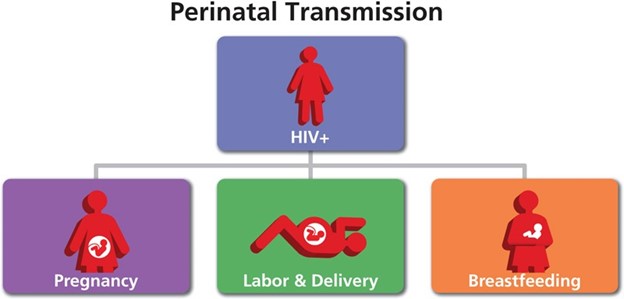Human immunodeficiency virus (HIV) may be perinatally transmitted:
Only in the third trimester from the maternal circulation.
By a needlestick injury at birth from unsterile instruments.
Only through the ingestion of amniotic fluid.
Through the ingestion of breast milk from an infected mother.
The Correct Answer is D
The correct answer is choice D. Perinatal transmission of HIV is when HIV is passed from a woman with HIV to her child during pregnancy, childbirth, or breastfeeding.

Breast milk from an infected mother can contain HIV and infect the baby.
Choice A is wrong because HIV can be transmitted at any stage of pregnancy, not only in the third trimester.
Choice B is wrong because needlestick injury is not a common mode of perinatal transmission of HIV. It is more likely to occur among health care workers who are exposed to contaminated needles or sharp objects.
Choice C is wrong because HIV can also be transmitted through the ingestion of amniotic fluid, but it is not the only way. Amniotic fluid is the fluid that surrounds and protects the baby in the womb.
Nursing Test Bank
Naxlex Comprehensive Predictor Exams
Related Questions
Correct Answer is B
Explanation
Measles (rubeola) is a communicable disease that is characterized by Koplik’s spots, which are clustered, white lesions on the buccal mucosa opposite the lower molars. They appear two to three days before the measles rash and are pathognomonic for measles.
Choice A is wrong because rubella is a different viral infection that causes a mild rash and fever, but does not have Koplik’s spots.
Choice C is wrong because chickenpox (varicella) is caused by the varicella-zoster virus and produces fluid-filled blisters on the skin, not white spots in the mouth.
Choice D is wrong because exanthema subitum (roseola) is caused by the human herpesvirus 6 or 7 and causes a high fever followed by a pink rash on the trunk and neck, but no oral lesions.
Correct Answer is C
Explanation
Placing eye shields over the newborn’s closed eyes. This is because phototherapy can cause eye damage and irritation to the newborn, so eye protection is essential.
Choice A is wrong because oil-based lotion can increase the absorption of heat and cause burns to the newborn’s skin.
Choice B is wrong because limiting the newborn’s intake of milk can cause dehydration and increase the risk of hyperbilirubinemia.
Choice D is wrong because changing the newborn’s position every 4 hours is not frequent enough to prevent pressure ulcers and ensure even exposure to the light.
Normal ranges for bilirubin levels in newborns are 1 to 12 mg/dL for term infants and 3 to 14 mg/dL for preterm infants. Phototherapy is usually indicated when the bilirubin level exceeds 15 mg/dL for term infants and 10 mg/dL for preterm infants.
Whether you are a student looking to ace your exams or a practicing nurse seeking to enhance your expertise , our nursing education contents will empower you with the confidence and competence to make a difference in the lives of patients and become a respected leader in the healthcare field.
Visit Naxlex, invest in your future and unlock endless possibilities with our unparalleled nursing education contents today
Report Wrong Answer on the Current Question
Do you disagree with the answer? If yes, what is your expected answer? Explain.
Kindly be descriptive with the issue you are facing.
